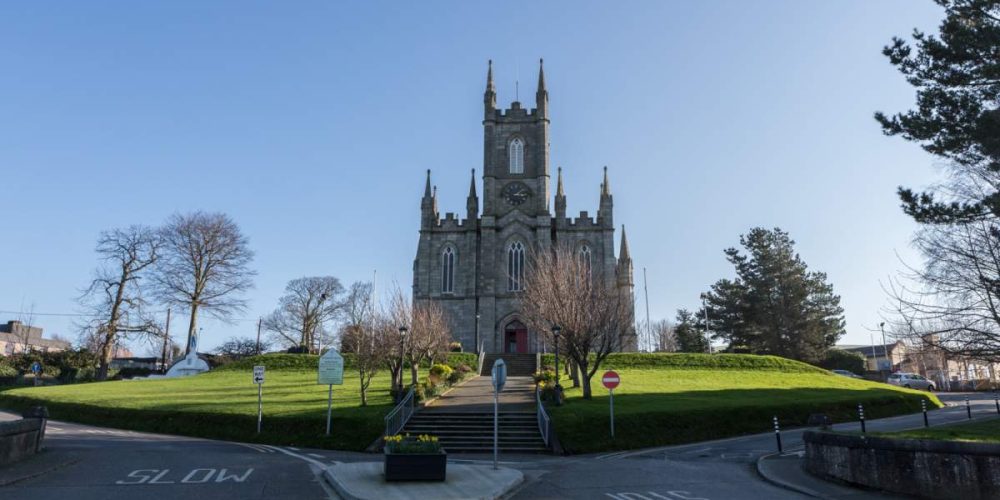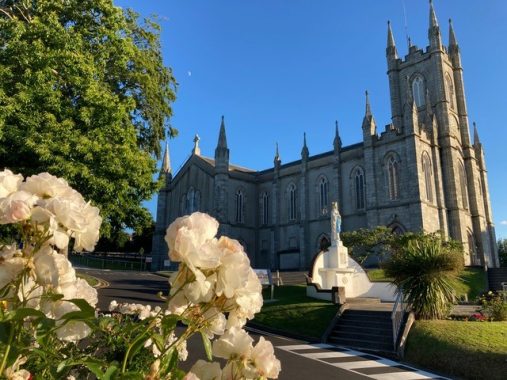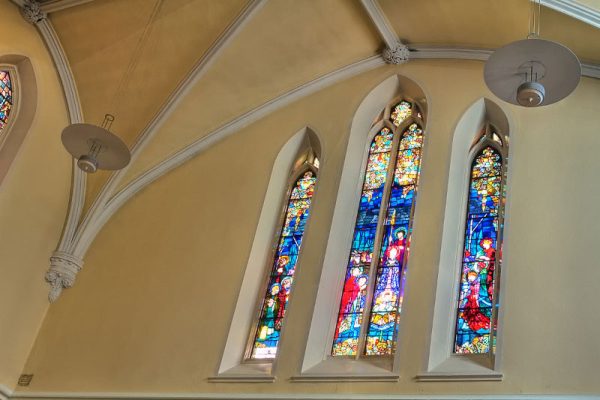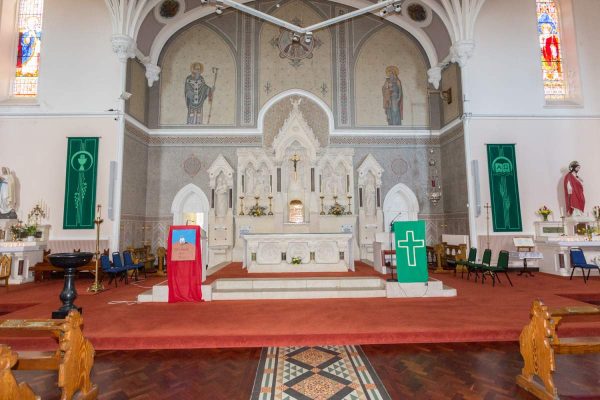
Archdeacon John Grant
Archdeacon John Grant, Parish Priest (1826-63), was a curate at Wicklow prior to his elevation as Parish Priest in 1826. On his appointment we come to the boundary of strong and living tradition in the parish. Archdeacon Grant conceived and set about the task of building a new parish church. It is to him, his deep faith and courage, and to the loyal support of the then people of Wicklow, that successive generations must thank for our beautiful Parish Church. In Porter’s guide to Co. Wicklow appeared the following:-
“The Catholic Church is a magnificent structure situated on an eminence overlooking the town and bay, and is a lasting monument to the tiny munificence and sacrifices of the Catholic Community of Wicklow. There are many beautiful Churches in the Diocese of Dublin, but very few can compare with Wicklow. Viewed from Church Hill, it looks like a continental Cathedral, and the interior decorations are very artistic, a special feature of which is the beautiful ceiling”.
Building of the Church in 1840’s
The people of Wicklow were very involved in the building of this Gothic style Church, local farmers drew the stone from the quarries and sailors transported limestone from Skerries, County Dublin. The Fitzwilliam family generously presented the site for the new Church to the Parish. In addition to the selfless generosity of the townspeople, contributions were received from Dublin, Wexford and England. Regretfully no knowledge exists of the architect or the builder of the Church.
 The Foundation Stone was laid in 1840. Archbishop of Dublin, Daniel Murray in the presence of a large and distinguished congregation celebrated the first Mass in ‘St. Patrick’s Church’ on Sunday, October 13. 1844. The High Altar of Caen stone was erected to the memory of Archdeacon Grant whose mortal remains together with those of his successor Father Patrick O’ Doherty (1864-76) rest in the vault in front of the high altar. The event for which Fr. O’ Doherty, is best remembered, and for which the parish will be forever indebted to him is the bringing of the Dominican Community to Wicklow. The Church Organ is dedicated to his memory.
The Foundation Stone was laid in 1840. Archbishop of Dublin, Daniel Murray in the presence of a large and distinguished congregation celebrated the first Mass in ‘St. Patrick’s Church’ on Sunday, October 13. 1844. The High Altar of Caen stone was erected to the memory of Archdeacon Grant whose mortal remains together with those of his successor Father Patrick O’ Doherty (1864-76) rest in the vault in front of the high altar. The event for which Fr. O’ Doherty, is best remembered, and for which the parish will be forever indebted to him is the bringing of the Dominican Community to Wicklow. The Church Organ is dedicated to his memory.
Features of the Church
The Bell is one of the finest in Ireland, of a rich mellow tone, and can be heard fully five miles away. It weighs four tonnes and was installed on November 24th 1889 by V. Rev. William Canon Dillon PP (1880-94). The tone of the Dublin made bell has been compared with that of another four-ton bell in the Basilica of St. John in Lateran, Rome. It was brought from the railway station to the Abbey corner on a gun carriage, which was borrowed from the Militia. From there it was pulled with ropes by the townspeople to the foot of its final destination.

Four of the church windows are of stained glass. The windows over the side altars show Our Lady and St. Patrick and were presented by a Mrs Lalor and a Captain Darragh respectively. It was to the memory of Fr. Thomas Carbery Parish Priest (1899-1906) that the window in the east transept was dedicated, and presented by his parishioners.
Particular mention should be made of the corresponding window in the west transept, from the Harry Clarke studio which, in the setting sun of evening, depicts in spectacular beauty the Birth of Christ, and was presented by a Mrs Murray of Main Street, Wicklow.
Restoration & Modernisation in the 20th Century
The Presbytery, which can be seen to the left of the church was destroyed by fire in 1930 and was rebuilt immediately afterwards. The original building dates from 1890.
John Canon Staples PP (1906-23) will be remembered for bringing the De La Salle Order to Wicklow in 1912. The Order administered both first and second level schools until their departure from Wicklow 1991. The gratitude of the people of Wicklow is due in no small measure to the members of the order for almost One Hundred years of dedicated service.
In more modern times, ongoing development, restoration and where necessary modernisation of the Church and its environs continues. During the incumbency of Fr. Matthew Blake (1949-59) a major redevelopment of the church grounds took place, together with the building of the shrine to Our Blessed Lady marking the Marian Year of 1954. The narrow pedestrian entrance to the grounds with a steep flight of steps at the Chapel Hill was replaced with several more gradual flights of wider steps. The environs of the Church were re-landscaped opening new vistas of the Church. A wide and more open entrance was constructed opposite the old church with additional car parking provided in the church grounds. The first modern sound system was installed in St. Patrick’s during this period.
 With the transition from the Latin Mass to the Vernacular, facilitating and encouraging more participation of the congregation came also a change in altar style. Instead of erecting a modern altar table as many churches did. Canon Anthony Crinion, Parish Priest (1970-83) had the magnificent altar skilfully divided and the table section moved forward. The furnishing of the surrounds of the high altar was completed only two years ago when Fr. Francis McDonnell Parish Priest, (1997-2005) had a new Ambo and Presidential Chair constructed in the style of the altar. The latter was presented by Monica Duggan in memory of the Duggan family.
With the transition from the Latin Mass to the Vernacular, facilitating and encouraging more participation of the congregation came also a change in altar style. Instead of erecting a modern altar table as many churches did. Canon Anthony Crinion, Parish Priest (1970-83) had the magnificent altar skilfully divided and the table section moved forward. The furnishing of the surrounds of the high altar was completed only two years ago when Fr. Francis McDonnell Parish Priest, (1997-2005) had a new Ambo and Presidential Chair constructed in the style of the altar. The latter was presented by Monica Duggan in memory of the Duggan family.
James L. Kavanagh, Chairman, Parish Pastoral Counci
Spring 2007.

